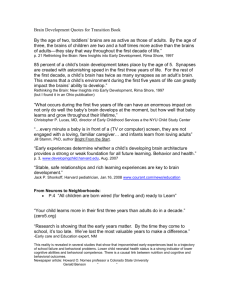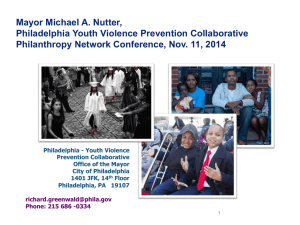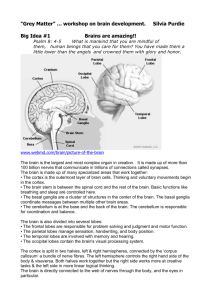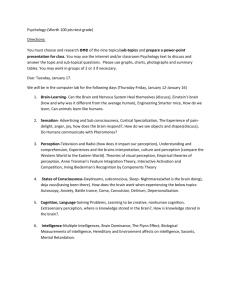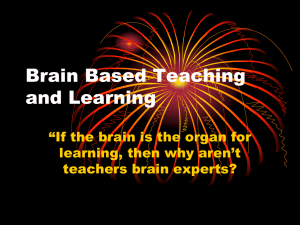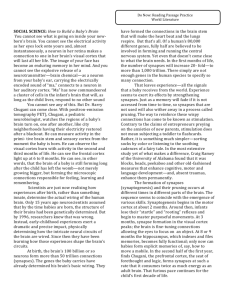The Amazing Brain - Institute for Safe Families
advertisement
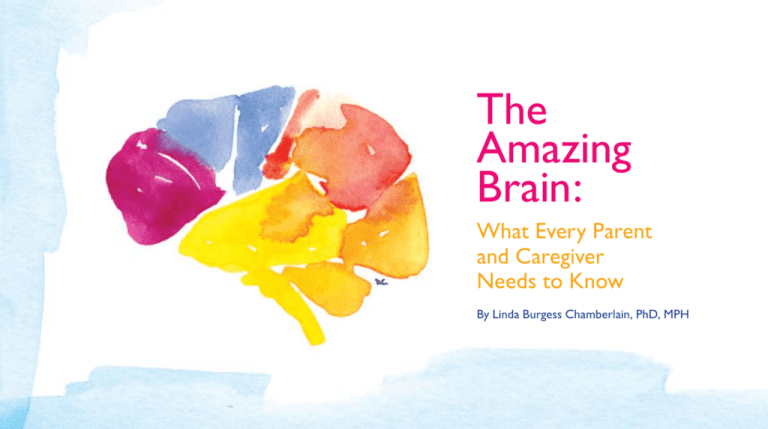
The Amazing Brain: What Every Parent and Caregiver Needs to Know By Linda Burgess Chamberlain, PhD, MPH Experience Shapes Our Brains How your child’s brain develops each and every day is being shaped by the environment and experiences you provide. The world your child lives in actually affects how their brain grows. Your child needs lots of new, positive experiences in a safe, stable home environment to build a healthy brain. Healthy relationships are the most important experience your child can have. We can help children grow healthy brains by following these six simple steps. Help Me Make Connections A baby’s brain is ready to connect. Babies build their brains by connecting with you and the world around them. At birth, a baby’s brain has 100 BILLION nerve cells called neurons that are waiting to connect. Each neuron can make thousands of connections or only a few depending on a child’s environment and experiences. Spending quality time with your child can increase your child’s brain power. You can help your baby build brain connections by talking, hugging, singing, reading, playing, and exploring the world together. The brain is a “use it or lose it” machine. There are windows of opportunity in early brain development. Some of these windows close very quickly. For example, areas of the brain involved in vision are connected by 18 months of age. If an infant’s vision is blocked by a cataract or an eye patch at the time when the brain needs to be making connections for vision, a child will lose the ability to ever see out of the affected eye. Be There For Me Children need the right experience at the right time. Learn as much as you can about age-appropriate activities to take advantage of windows of opportunity for your child’s brain development. For example, children can learn to speak a second language without an accent. This window of opportunity starts to close as a teenager and it becomes much harder to learn and speak a second language without an accent. Healthy, caring relationships are food for a child’s growing brain. By 6 months of age, babies can tell the difference between faces they know and don’t know just as well as you can! By 18 months of age, the areas of the brain that control emotions are connecting. Babies learn about healthy relationships and how to handle stress from you, so if you are stressed, your baby will be too. Your child needs you to love them, comfort them, and encourage them. Make sure that other caregivers are also providing a safe, nurturing environment for your child. Understand The Building Blocks Of My Brain A child’s brain develops from the bottom up like a stack of building blocks. The brainstem and mid-brain are the first areas of the brain to develop and connect. These areas are called the “survival brain” because they control body functions that keep us alive such as blood pressure and body temperature. The limbic system is the next building block of the brain. When you have a “gut response” about something, this comes from the limbic system in your brain which handles our basic emotions. The top building block of the brain is the cortex. This is the last area of the brain to mature. The cortex is responsible for our most complicated thinking from decision-making to multi-tasking to controlling our emotions. Reading, writing, language, and arithmetic are all cortex functions so children need to spend lots of time in this area of their brains to learn these new skills. Build My Self-Esteem Intellectual Brain Survival Brain It’s more than just words. We can build a child’s self-esteem through praise, encouragement, and positive experiences. Children need to hear that we believe in them and that they can be whatever they want to be. Give your child opportunities to succeed at new tasks and develop skills. From praising your child for sharing a toy with another child to teaching them how to climb up the stairs, your encouraging words can boost your child’s confidence and ability to face challenges. I Need To Feel Safe Children need to feel safe. Creating a safe home isn’t just the things you do to prevent your child from getting hurt such as plugging outlets, putting safety gates on stairways, and keeping poisons out-of-reach. It’s about creating a predictable, stable environment for your child. When a child feels safe and nurtured, they can focus their energy on upper brain development and learning. Keep Being There! Children growing up in fear or chaos tend to spend more time in “survival brain” trying to feel OK. They adapt to their environment, but it comes at a high cost. Because these children are spending less time in the cortex or “thinking brain,” they often have problems paying attention, sitting still, and controlling their emotions. There are big brain changes during adolescence. Adolescents do not have all the hardware in their brains yet to think like an adult. The adolescent brain goes through major remodeling that starts around puberty and continues into the early 20’s. Teens need parents and caregivers in their lives more than ever to help them finish building their brains. How teens spend their time matters! Some Information You Should Know A baby’s brain uses THREE TIMES the amount of energy that your brain does—that’s a busy brain!! By 6 years of age, a child’s brain will be 95% of its adult size and have more connections than all the stars and planets in the galaxies. Resources For Help And Additional Information Children who watch more television during the first three years of life are more likely to have problems with attention deficit disorders when they are 7 to 9 years old. BrainConnection.com This Web site provides information about how the brain works and how people learn. Many discoveries are being made in areas that relate to the human brain, including language, memory, behavior, and aging, as well as illness and injury. BrainConnection.com also provides practitioner-friendly tools for teaching and learning. www.Brainconnection.com Child Trauma Academy The Child Trauma Academy, a not-for-profit organization based in Houston, Texas, is a collaborative of individuals and organizations working to improve the lives of high-risk children through direct service, research and education. www.childtrauma.org The National Child Traumatic Stress Network The NCTSN was established to improve access to care, treatment, and services for traumatized children and adolescents exposed to traumatic events. www.nctsnet.org The Philadelphia Compact The Philadelphia Compact is a coalition of City agencies, community leaders, and service organizations working together and playing an ongoing role to ensure all children living in our city have access to quality, affordable, and appropriate behavioral health services. www.philadelphiacompact.org Zero-to-Three This site offers a comprehensive interactive resource for parents and early childhood education professionals on healthy development of children ages zero to three. www.zerotothree.org .VMUJQMZJOH $POOFDUJPOT The Amazing Brain: What Every Parent and Caregiver Needs to Know, 2008, Philadelphia, PA. This brochure was written by Linda Burgess Chamberlain, PhD, MPH with support from the Institute for Safe Families and Multiplying Connections of the Health Federation of Philadelphia. Linda Burgess Chamberlain is the founding director of the Alaska Family Violence Prevention Project. An epidemiologist specializing in domestic violence, she is an internationally recognized speaker on the effects of violence on children and brain development. She lives on a rural homestead outside of Homer, Alaska with her dog team. A national Kellogg Leadership Fellow, Dr. Chamberlain is also a motivational speaker and uses “lessons from the trail” to promote key strategies for teamwork and leadership. howlinghusky@gci.net The Institute for Safe Families (ISF) is a non-profit organization whose mission is to prevent family violence and promote the health and well being of each member of the family and their community. Since the early 1990’s, ISF has developed innovative programming and built coalitions that unite health care providers with social service, policy experts, researchers, academicians, and victim/survivors. One of ISF’s unique strengths has been to create forums for cross-systems dialogue aimed at building greater capacity for more effective prevention and response to family violence. www.instituteforsafefamilies.org Multiplying Connections of The Health Federation of Philadelphia is a cross system collaborative whose mission is to translate the research on early childhood brain development into better practice through professional training and organizational and policy change. Multiplying Connections is developing materials and strategies to promote trauma informed and developmentally appropriate care across the public child and family service system in the City of Philadelphia. This capacity building initiative is funded by the William Penn Foundation. www.multiplyingconnections.org Design and Illustration: Peter Camburn About Face Design www.aboutfacedesign.net
